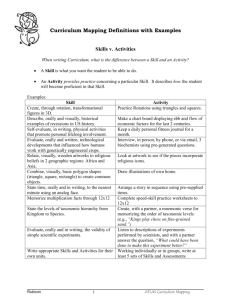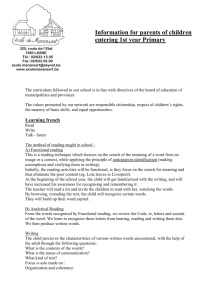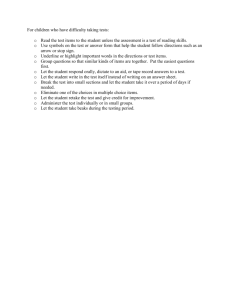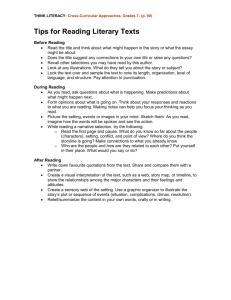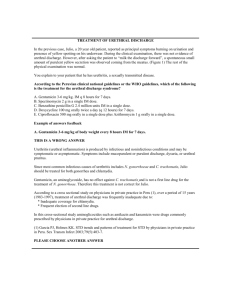Click to add title
advertisement
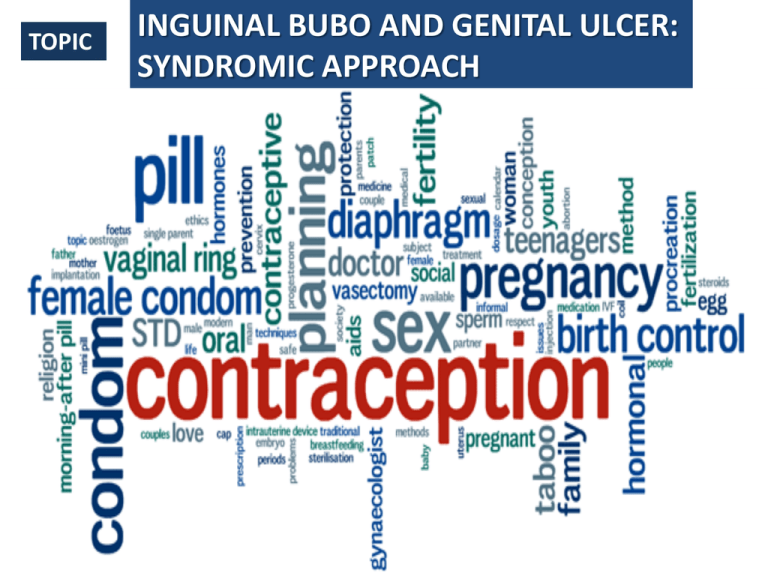
TOPIC INGUINAL BUBO AND GENITAL ULCER: SYNDROMIC APPROACH Dr. Rohit Kumar Singh Resident, MD Dermatology Base Hospital URETHRAL DISCHARGE PERSISTANT UETHRAL DISCHARGE SCROTAL SWELLING VAGINAL DISCHARGE VAGINAL DISCHARGE (SPECULUM AND BlMANUAL) VAGINAL DISCHARGE (SPECULUM AND MICROSCOPE) LOWER ABDOMINAL PAIN LOWER ABDOMINAL PAIN Recommended syndromic treatment 1. ceftriaxone, 250mg by intramuscular injection, once daily PLUS • doxycycline, 100mg orally or by intravenous injection, twice daily, or tetracycline, 500mg orally 4 times daily PLUS • metronidazole, 400-500mg orally or by intravenous injection, twice daily, or chloramphenicol, 500mg orally or by intravenous injection, 4 times daily. 2. clindamycin, 900mg by intravenous injection, every 8 hours PLUS • gentamicin, 1.5 mg/kg by intravenous injection every 8 hours. 3. ciprofloxacin, 500mg orally, twice daily, or spectinomycin 1g by intramuscular injection, 4 times daily PLUS • doxycycline, 100mg orally or by intravenous injection, twice daily, or tetracycline, 500mg orally, 4 times daily PLUS • metronidazole 400-500mg orally or by intravenous injection, twice daily, or chloramphenicol, 500mg orally or by intravenous injection, 4 times daily. Note • For all three regimens, therapy should be continued until at least 2 days after the patient has improved and should then be followed by either doxycycline, 100mg orally, twice daily for 14 days, or tetracycline, 500mg orally, 4 times daily, for 14 days. Patients taking metronidazole should be cautioned to avoid alcohol. Tetracyclines are contraindicated in pregnancy. NEONATAL CONJUNCTIVITIS NEONATAL CONJUNCTIVITIS Neonatal conjunctivitis (ophthalmia neonatorum) can lead to blindness when caused by N. gonorrhoeae. The most important sexually transmitted pathogens which cause ophthalmia neonatorum are N. gonorrhoeae and C. trachomatis. In developing countries, N. gonorrhoeae accounts for 20-75% and C. trachomatis for 15-35% of cases brought to medical attention. Other common causes are Staphylococcus aureus, Streptococcus pneumoniae, Haemophilus spp. and Pseudomonas spp. Newborn babies are generally presented because of redness and swelling of the eyelids or "sticky eyes", or because of discharge from the eye(s). As the clinical manifestations and possible complications of gonococcal and chlamydial infections are similar, In settings where it is impossible to differentiate the two infections, treatment should be provided to cover both infections. This would include single dose therapy for gonorrhoea and multiple dose therapy for chlamydia. Drug options for Drug options for gonorrhoea chlamydia Ceftriaxone Alternatives Kanamycin Spectinomycin Erythromycin Alternatives Trimethoprim/Sulf amethoxazole INTRODUCTION • The term sexually transmitted diseases (STDs) is used to refer to a variety of clinical syndromes caused by pathogens that can be acquired and transmitted through sexual activity • Sexually transmitted infections (STIs) are among the most common causes of illness in the world and have far-reaching health, social and economic consequences for many countries. STI vs STD • STI – Infections acquired through sexual intercourse (may be symptomatic or asymptomatic) • STD – Symptomatic disease acquired through sexual intercourse • STI is most commonly used because it applies to both symptomatic and asymptomatic infections 14 How Symptomatic are STIs? Source: WHO HIV/AIDS/STI Initiative 15 IMPACT OF STIs • • • • • • 16 Considerable morbidity High rate of complications Facilitate HIV transmission and acquisition May cause infertility Treatment can be a high financial burden May cause problems in relationships—divorce, abandonment, beatings. INTERACTION BETWEEN HIV AND STIs • Significant interaction exists b/w HIV and STIs – Affect similar populations – Have a similar route of transmission • The interaction is bidirectional – HIV influences conventional STIs – STIs influence HIV 17 INFLUENCE OF HIV INFECTION ON STIs • HIV alters the clinical features of STIs – Syphilis: Neurosyphilis develops more frequently and rapidly – HSV: Ulcers are more severe, chronic, and possibly disseminate throughout body • Response to treatment may be reduced – High rates of treatment failure for neurosyphilis • Complications may increase and occur more quickly 18 HOW DO STIs INCREASE HIV TRANSMISSION? • Reducing physical/mechanical barriers (disruption of epithelium) • Increasing HIV in genital lesions, semen or both • Evoking a more infectious HIV variant • Increasing the number of receptor cells or the density of receptors per cell THREE APPROACHES TO DIAGNOSIS OF RTI / STI • Clinical approach • Etiological approach • Syndromic approach SYNDROMIC APPROACH • Syndromic management is based on the identification of consistent groups of symptoms and easily recognized signs (syndromes), and the provision of treatment that will deal with the majority or most serious organisms responsible for producing a syndrome. WHO developed a simplified tool (a flowchart or algorithm) to guide health workers in the implementation of syndromic management. COMPONENTS OF SYNDROMIC APPROACH Classification by Syndrome: Classifying the main causal pathogens by the syndromes they produce Use of Algorithms: Using flowcharts to guide the management of a given syndrome Treatment and Counseling: Using often more than one treatment that addresses all the pathogens with potential to cause a given syndrome Treatment of Partners: Promoting treatment of sex partners MAIN SYNDROMES • • • • • • • Urethral discharge Genital ulcer Scrotal swelling Vaginal discharge Lower abdominal pain Neonatal conjunctivitis Inguinal bubo SYNDROMIC CASE MANAGEMENT ADVANTAGES: • • • • • • Identifies and treats by signs & symptoms Syndromes easily recognised clinically Small number of clinical syndromes Treatment given for majority of organisms Simple and cost-effective Valid, feasible, immediate treatment 24 SYNDROMIC CASE MANAGEMENT DISADVANTAGES: • Tendency to overtreat – justifiable in high prevalence settings (>20%) • Decreased specificity • Overuse of expensive drugs • Asymptomatic cases not fully addressed even with risk assessment • Management of cervical infections problematic • Vaginal discharge algorithm performs poorly in low prevalence settings e.g., ANC, FP 25 Patient complaining of inguinal swelling INGUINAL BUBO SYNDROME Take history and examine Inguinal/femoral bubo present? No Any other STI present No Yes Use appropriate flow chart Ulcers present Yes Use genital ulcer flow chart No 26 Treat for LGV AND CHANCROID •Aspirate if fluctuant •Educate on treatment compliance •Counsel on risk reduction •Promote and provide condoms •Partner management •Offer VCT if available •Advise to return in 07 days •Refer if no improvement •Educate •Counsel •Offer VCT •Promote and provide condoms INGUINAL BUBO SYNDROME INGUINAL BUBO • Swelling of inguinal lymph nodes as a result of STIs (or other causes) • Common causes: – Treponema pallidum (syphilis) – Chlamydia trachomatis L1, L2,L3 (LGV) – Hemophilus ducreyi (chancroid) – Calymmatobacterium granulomatis (granuloma inguinale) 28 LYMPHOGRANULOMA VENEREUM • Tropical or Climatic bubo • • Durand-Nicholas-Favre disease • Lymphogranuloma inguinale • Poradenitis inguinalis • Strumous bubo EPIDEMIOLOGY • 6% Prevalence Rate in Clinics • Endemic to India • 20 - 40 yrs. • Male : female = 5 :1 • Urban, sexual promiscuity, low socio- economic status. AETIOLOGY • Chlamydia Serovar L1/L2/L3 • Obligate intracellular, Gram negative bacillus with humans as Natural Hosts by Sexual Transmission / Perinatal infection • Intracytoplasmic inclusion bodies • Controls the organelles of host cells for own growth and protein synthesis • Cell cycle – 48 to 72 hrs PATHOGENESIS • Entry into cell as Metabolically inactive elementary body (Eb) by receptor mediated endocytosis. • Conversion to Active Reticulate Bodies which multiply , condense and form Eb burst out of host cells • Lymphangitis, perilymphangitis, necrosis of lymph nodes • PMN stellate abscess- bubo • Healing by fibrosis - esthiomene, adhesions • Dissemination rare CLINICAL FEATURES Primary stage Incubation period : 5 – 21 days. Single, painless, evanescent, inconspicuous Papule / vesicle / Erosion / Ulcer Male – coronal sulcus, prepuce, glans, urethra Female - endocervix, post vaginal wall Oral / Rectal localization NSU BUBONULUS – Lymphangitic nodules over dorsal penis Chord-like swelling Constitutional symptoms SECONDARY ‘INGUINAL’ STAGE • 10 – 30 days after primary lesion • Inflammatory swelling of Inguinal nodes in males perirectal and iliac nodes in females ‘BUBOES’ Fluctuant if untreated Multilocular Suppuration (70%) • Unilateral 2/3rd cases • Constitutional symptoms with bubo • Blue ball sign / Livid colour of overlying skin over Bubo predicts rupture • Groove sign of Greenblat (20%) SECONDARY STAGE Dissemination (Rare, hematogenous) • Arthritis • Ocular inflammatory disease • Pneumonitis • Hepatitis • EN / EM / EAC TERTIARY STAGE • Develops in 25% of untreated • GENITO-ANO-RECTAL syndrome, more common in women / MSM Clinical features •Hyperplastic Ulcerative lesions • Proctocolitis • Bloody purulent discharge • Pruritis Ani • Tenessemus TERTIARY STAGE • Lymphatic tissue hyperplasia (LYMPHORROIDS / PERI-ANAL CONDYLOMAS) • Chronic Ulceration / Scarring • Fistulae / Strictures (Urethral syndrome) • Saxophone penis • Esthiomene Mechanisms Anal Intercourse Posterior Urethral spread Direct Spread from Vaginal Secretions Lymphatic Dissemination by Cx COMPLICATIONS • Ca rectum (2-5%) • Epididymo-orchitis • Prostatitis • Seminal vesiculitis • Malignant change in esthiomene EXTRAGENITAL MANIFESTATIONS • • • • Ocular manifestations Can occur at any stage Common with L2 Conjunctivitis, Episcleritis, Keratitis, Iritis Submaxillary, post auricular LN Cutaneous manifestations • Id eruptions (photodermatitis) • Ilio-Psoas Abscess INVESTIGATIONS • Microscopy / Identification Gram stain, Giemsa stain, Warthin Starry, Machiavello • Isolation Culture on McCoy / HeLa Cell Line (Brown Inclusion bodies) • Histopathology – Stellate Abscesses / PMNs granulomatous reaction • Serological tests: CFT, PCR, NAAT, immunofluorescence • CT / MRI, Lymphography • Skin (Frei) test TREATMENT OF LGV Recommended syndromic treatment ■ Doxycycline, 100 mg orally, twice daily for 21 days OR ■ Erythromycin, 500 mg orally, four times daily for 21 days GENITAL ULCER SYNDROME Patient complains of genital ulcer Take history & examine Vesicles or recurrence Yes Treat for HSV, Treat for syphilis if indicated •Educate and counsel •Promote and provide condoms •Offer VCT •Ask the patient to return in 7 days No OR PAINFL OR PAINLESS LN +/•Educate No •Promote and Ulcers and sores provide condoms Yes •Offer VCT Treat for syphilis, chancroid and HSV DO VDRL OR RPR No Ulcers healed No Ulcers improving Refer Yes Educate and counsel Promote and provide condoms Offer VCT Partner management 42 Yes Continue treatment for further 07 days GENITAL ULCER SYNDROME CHANCROID • • • • • SOFT CHANCRE Haemophilus ducreyi Small coccobacillus Gram – negative IP – 3 – 5 days CHANCROID PRESENTATION • Genital ulcers – – – – – – Often Multiple, saucer shaped ulcers with erythematous halo With Sharply Defined, undermined edges Painful Non - indurated Exudative Base Bleed When traumatized (grey membrane) • Inguinal lymph nodes – Tender – Unilateral (> ⅔ ) – Unilocular abscess ( BUBO) – Suppurative – Drain spontaneously with single sinus formation CLINICAL VARIANTS 1. 2. 3. 4. 5. 6. 7. 8. 9. Giant Dwarf Large serpiginous ulcer(ulcus molle serpiginous) Pagedaemic ( ulcus molle gangrenosum) Transient ( ulcus molle volant) Follicular Pseudo grranuloma inguinale Mixed Chancroidal chancroid COMPLICATIONS • • • • • • • • • Painful adenitis Abscess and fistula – inguinal Kissing ulcer – extragenital spread Esophageal lesion in HIV pt Acute conjunctivitis Bacterial superinfection Scarring leads to phimosis Erythema nodosum / EM Enhance HIV transmission ( 3- 10 fold increase) CHANCROID DIAGNOSIS • Smear examination – Gram, Giemsa and Wright’s stains – Rail – track appearance • Culture – Own clotted blood, fetal calves – Shoals of fish • Serology – CFT • Skin test ( Ito-Reenstierna reaction) • Biopsy is seldom helpful CHANCROID TREATMENT Recommended regimen ■ Ciprofloxacin, 500 mg orally, twice daily for 3 days OR ■ Erythromycin base, 500 mg orally, 4 times daily for 7 days OR ■ Azithromycin, 1 g orally, as a single dose Alternative regimen ■ Ceftriaxone, 250 mg by intramuscular injection, as a single dose GRANULOMA INGUINALE • DONOVANOSIS • 1st described by McLeod(1882) in Madras, India. • Etiology – Klebsiella granulomatis – Pleomorphic, Gram negative rod – Safety pin appearance – 99% phylogenetic homology with K. pneumoniae – Difficult to grow in culture GRANULOMA INGUINALE(Donovanosis) • IP – 1 to 12 wks • Early lesion – vesicle or button like papule • Ulcer characteristics – Sharply defined edges – Serpiginous border – Beefy red granulation tissues - Firm base – Bleeds on touch – Painless – Pseudo bubo(subcut. granulomas ) GRANULOMA INGUINALE • Complications – Phagedemic ulcerations – Keloid scarring – Elephantoid enlargement of penis and scrotum – Stenosis of urethral, vaginal and anal orifices – Metastatic spread to bones (vertebrae) GRANULOMA INGUINALE: DIAGNOSIS • Tissue smears – Most effective – From edge of lesions – Giemsa, Wright, Leishman or Gram stain – CELLS OF GREEBLATS – Silver stains • Culture – Tissue and egg culture • Serum tests – CFT • Biopsy – Pseudo-epithelial hyperplasia of marginal epithelium – Plasma cell infiltration of corium GRANULOMA INGUINALE(DONOVANOSIS): TREATMENT Recommended Regimen • Doxycycline 100 mg orally twice a day for at least 3 weeks and until all lesions have completely healed Alternative Regimens Azithromycin 1 g orally once per week for at least 3 weeks and until all lesions have completely healed OR Ciprofloxacin 750 mg orally twice a day for at least 3 weeks and until all lesions have completely healed OR Erythromycin base 500 mg orally four times a day for at least 3 weeks and until all lesions have completely healed OR Trimethoprim-sulfamethoxazole one double-strength (160 mg/800 mg) tablet orally twice a day for at least 3 weeks and until all lesions have completely healed HERPES GENITALIS • • • • • • DNA double stranded virus, linear 125-250 Kb long, relatively big Enveloped Virion size 200 nm, relatively big 9 HSVs, Ex. Varicella, EBV, CMV Diseases: Chickenbox, Mononucleosis, Hepatitis, Encephalitis • Recurrent eye, mouth and genital lesions Clinical Manifestations FIRST EPISODE PRIMARY INFECTION • Characterized by multiple lesions that are more severe, last longer, and have higher titers of virus than recurrent infections • Typical lesion progression: papules vesicles pustules ulcers crusts healed • Often associated with systemic symptoms including fever, headache, malaise, and myalgia • Illness lasts 2-4 weeks HERPES GENITALIS Multiple grouped vesicles Erythematous sharp margin Painful Firm tender B/L lymph node Clinical Manifestations FIRST EPISODE PRIMARY INFECTION: WITHOUT TREATMENT • Numerous, bilateral painful genital lesions; last an average of 11-12 days • Local symptoms include pain, itching, dysuria, vaginal or urethral discharge, and tender inguinal adenopathy • Median duration of viral shedding detected by culture (from the onset of lesions to the last positive culture) is ~12 days • HSV cervicitis occurs in most primary HSV-2 (70-90%) and primary HSV-1 (~70%) infections Clinical Manifestations RECURRENT INFECTION • Prodromal symptoms are common (localized tingling, irritation) - begin 12-24 hours before lesions • Illness lasts 5-10 days • Symptoms tend to be less severe than in primary infection • Generally no lymphadenopathy • Usually no systemic symptoms • HSV-2 primary infection more prone to recur than HSV-1 Diagnosis VIROLOGIC TESTS • Viral culture (gold standard) • • • • • • Preferred test if genital ulcers or other mucocutaneous lesions are present Highly specific (>99%) Sensitivity depends on stage of lesion; declines rapidly as lesions begin to heal Positive more often in primary infection (80%–90%) than with recurrences (30%) Cultures should be typed Polymerase Chain Reaction (PCR) • • More sensitive than viral culture Preferred test for detecting HSV in spinal fluid Diagnosis VIROLOGIC TESTS • Antigen detection (DFA or EIA) • Fairly sensitive (>85%) in symptomatic shedders • Rapid (2-12 hours) • May be better than culture for detecting HSV in healing lesions • Cytology (Tzanck smear) • Insensitive and nonspecific and should not be relied on for HSV diagnosis Diagnosis TYPE-SPECIFIC SEROLOGIC TESTS • • • • Type-specific and nonspecific antibodies to HSV IgM – acute infection Ig G – chronic infection, persists for life long HSV-2 antibody indicates anogenital infection HSV-1 does not distinguish anogenital from orolabial infection HERPES GENITALIS : TREATMENT Recommended regimen for first clinical episode ■ Acyclovir, 200 mg orally, 5 times daily for 7 days OR ■ Acyclovir, 400 mg orally, 3 times daily for 7 days OR ■ Valaciclovir, 1 g orally, twice daily for 7 days OR ■ Famciclovir, 250 mg orally, 3 times daily for 7 days HERPES GENITALIS : TREATMENT Recommended regimen for recurrent infection ■ Acyclovir, 200 mg orally, 5 times daily for 5 days OR ■ Acyclovir, 400 mg orally, 3 times daily for 5 days OR ■ Acyclovir, 800 mg orally, twice daily for 5 days OR ■ Valaciclovir, 500 mg orally, twice daily for 5 days OR ■ Valaciclovir, 1000 mg orally, once daily for 5 days OR ■ Famciclovir, 125 mg orally, twice daily for 5 days HERPES GENITALIS : TREATMENT Recommended regimen for suppressive therapy ■ Acyclovir, 400 mg orally, twice daily, continuously OR ■ Valaciclovir, 500 mg orally, once daily OR ■ Valaciclovir, 1000 mg orally, once daily OR ■ Famciclovir, 250 mg orally, twice daily HERPES GENITALIS : TREATMENT Recommended regimen for severe disease ■ Acyclovir, 5–10 mg/kg IV, every 8 hours for 5–7 days or until clinical resolution is attained Recommended regimen in severe herpes simplex lesions with coinfection with HIV ■ Acyclovir, 400 mg orally, 3–5 times daily until clinical resolution is attained Recommended regimen for neonates ■ Acyclovir, 10 mg/kg intravenously, 3 times a day for 10– 21 days PRIMARY SYPHILIS (The Chancre) • IP- 9-90 days, usually ~21 days. • Develops at site of contact/inoculation. • Ulcer ( HARD CHANCRE/HUNTARIAN CHANCRE/EROSIVE CHANCRE) – single, painless, clean-based, indurated ulcer, with firm, raised borders. Atypical presentations may occur. • Site: – Mostly anogenital, but may occur at any site (tongue, pharynx, lips, fingers, nipples. • Non-tender regional adenopathy • Very infectious. • May be darkfield positive but serologically negative. • Untreated, heals in several weeks, leaving a faint scar. PRIMARY SYPHILITIC CHANCRE Sharply demarcated Elevated Round/oval Smooth clean looking floor Indurated base Painless Firm discrete B/L LN DIAGNOSIS OF SYPHILIS • Evaluation based on three factors: – Clinical findings. – Demonstration of spirochetes in clinical specimen. – Present of antibodies in blood or cerebrospinal fluid. • More than one test should be performed. • No serological test can distinguish between other Treponemal infections. 70 LABORATORY TESTING • Direct examination of clinical specimen by dark-field microscopy or fluorescent antibody testing of sample. • Non-specific or non-treponemal serological test to detect reagin, utilized as screening test only. • Specific Treponemal antibody tests are used as a confirmatory test for a positive reagin test. SERUM TEST FOR SYPHILIS ANTIBODY ANTIGEN PRINCIPLE TESTS Non – specific ( anti- lipoidal) Cardiolipin Complement fixation CWR Cardiolipin coated particles flocculation VDRL RPR ART Extract of non – pathogenic trep. Complement fixation Reiter protein CFT Immobilization TPI Immunofluorescence FTA-Abs Disrupted trep. Enzyme linked assays ELISA Disrupted trep. Coated RBCs Haemagglutination TPHA Group – specific ( all treponemes) Specific (pathogenic Live trep. treponemes) Dead trep. SYPHILIS : TREATMENT Recommended regimen ■ Benzathine benzylpenicillin,2.4 million IU by intramuscular injection, at a single session. Because of the volume involved, this dose is usually given as two injections at separate sites Alternative regimen ■ Procaine benzylpenicillin,1.2 million IU by intramuscular injection, daily for 10 consecutive days SYPHILIS : TREATMENT Alternative regimen for penicillin-allergic nonpregnant patients ■ Doxycycline, 100 mg orally, twice daily for 14 days OR ■ Tetracycline, 500 mg orally, 4 times daily for 14 days Alternative regimen for penicillin-allergic pregnant patients ■ Erythromycin, 500 mg orally, 4 times daily for 14 days Syphilitic chancre Herpes genitalis Chancroid LGV Donovanosis IP 9 – 90 days 2-7 days 1-5 days 3 d- 6 wks 1-4 wks Initial lesion Papule Vesicle Papule/ pustule Papule , pustle/ Vesicle Papule Subcutaneo us nodule Number One Multiple Multiple One Variable Size (mm) 5-15 1-2 2-20 2-10 Variable Edge/margi n Sharply Demarcated, Round/oval Erythematous Sharp Undermined Ragged Irregular Elevated Round Oval Elevated Irregular Depth Superficial/ Deep Superficial Excavated and Superficial Deep Elevated Irregular Floor Smooth, Clean looking Serous Erythematous Purulent Necrotic Variable Beefy red granulation Base Indurated None Soft Firm Firm Tenderness Painless Common Very tender Variable Uncommon LNpathy Firm , discrete Shotty, Bilateral Firm tender Bilateral Tender, unilocular U/L, single sinus Tender , Multiloculated rupture from multiple sinuses Pseudobubo Unilateral CHILDREN, ADOLESCENTS AND SEXUALLY TRANSMITTED INFECTIONS • Sexual abuse of children and adolescents has come to be recognized as a serious social problem. • Infection may be asymptomatic. • If remains undiagnosed and untreated may result in an unanticipated complication at a later stage and may be transmitted to others. • The identification of a sexually transmissible agent in a child beyond the neonatal period, in the vast majority of cases, is suggestive of sexual abuse • Most cases of sexual abuse involve relatives, friends and other adults in close and legitimate contact with the child or adolescent. THANK YOU SYNDROMIC APPROACH OF URETHRAL DISCHARGE IN MALES Dr AMRITA KUMARI RESIDENT,DERMATOLOGY BASE HOSPITAL,LKO Objectives • To review the facts: STIs enhances the acquisition and transmission of HIV • To review the syndromic approach to management • To demonstrate the use of the algorithms 79 How do STIs increase HIV transmission? • Reducing physical/mechanical barriers (disruption of epithelium) • Increasing HIV in genital lesions, semen or both ( even if VL is undetectable) • Evoking a more infectious HIV variant • Increasing the number of receptor cells or the density of receptors per cell 80 STI – Syndromic Case Management REQUIREMENTS: • • • • • Adequate medical history Good sexual history Complete STI clinical examination Management guidelines Good supply of effective drugs 84 Essential Steps In STI Care Management* Syndrome Assessment Contact tracing (diagnostic tools) Diagnosis Treatment Compliance 5Cs (screening tests) Confidentiality Condom use Counseling Risk Assessment * Adapted from Holmes & Ryan 85 Risk Assessment Include: • Sexual behaviour • Specific exposures • Socio demographics/other high risk markers: – young age – marital status: not living with steady partner – partner problems • History of reproductive health • History of past STI 86 STI Control Program • Basic activities of STI prevention activities (for primary and secondary prevention strategies) – Primary infection: prevent new infection – Secondary prevention: prevent complication 87 WHO recommendation for STI control Program Primary prevention measures 1. Health education and promotion of safer sex and risk reduction 2. Promotion of condoms (Wide spread availability and affordability of Condom) 3. Information campaigns on the association between HIV and STI 88 Secondary prevention 1. Promotion of early health care seeking behavior 2. Accessible, effective and acceptable care -Integration of STD care into all basic health care facilities 3. Promotion of early use of health care services ( STD patients and their partners) 4.Early detection and treatment of asymptomatic infections through case finding Screening for asymptomatic patients eg, SY serology in pregnant women, CT tests in CSWs 89 Basic model for the reproductive rate of new infection in a population R0 = Dc • Basic reproductive rate (Ro): • Average of likelihood of transmission of the disease pathogen () • Average rate of exposure of susceptible to infectious people in the population (C) • Average duration of infectiousness (D) 90 Intervention points according to the determinants of STI transmission Exposure of a susceptible person C Intervention point Acquisition of infection Persistence and infectivity of infection D 91 Intervention that reduce exposure to STI (C) • Target on determinants of Sexual behavior • Potential activities: – Promotion of delayed initiation of sex among youth adolescents, abstinence, monogamy, reduce rates of sex partner change, avoidance of concurrent sexual partnerships – Clinic level Health education for risk reduction – Community-level interventions to modify community norms toward less acceptance of specific, high-risk behaviors. – School Health education program 92 Intervention that could shorten duration of infectivity (D) • Active case finding through widespread access to acceptable and good quality clinical care, screening, and contact tracing • Prompt and effective diagnosis and treatment for symptomatic persons • Clinical practice guideline (emphasis on syndromic or rapid test) • Screening practices for asymptomatic infection • Promoting awareness among potentially infected persons (having symptom of STI) • “Epidemiologic treatment” selective mass treatment • Outbreak investigation (rare disease) 93 Intervention that reduce efficacy of STI transmission during sexual exposure () • Increase consistence and correct use of barrier contraceptive methods – (eg, condom, spermicides) • Decrease specific risky sexual practices – (eg, penetrative sex) • Vaccine – Hepatitis B – HPV 94 Vertical program and horizontal program Advantage Vertical (STI Clinic) Horizontal (general care) -Well equipped clinic -More accessible -Well train staff -Used more by women -Good diagnostic services -Less stigmatizing 95 Disadvantage Vertical - Access often restricted for much of population - Stigmatizing - Expensive Horizontal - Quality of patient care can be variable - Overwork and poorly trained staff - Poor diagnostic services - Limited drugs 96 Good quality care and management - appropriated drug (efficacy, low cost) - education - counseling - treatment of sexual partners Treatment: rely on - efficacy - acceptability - low cost - antibiotic resistance considerations 97 Partner notification Partner management - epidemiology treatment - Laboratory diagnosis (if available) - education and counseling 98 Targeted interventions • Sex workers, MSM and injecting drug users. • STI services for these and other high-risk population groups need to be scaled up universally, making them a regular component of primary and sexual and reproductive health care. 99 Intervention in Commercial Sex workers 100 STI services for CSW • Periodic health checkup – Clinic (government, private) – Mobile Clinic • Effective treatment ( MININUM OR FREE OF CHARGE) – Individual – Mass treatment 101 URETHRAL DISCHARGE URETHRAL DISCHARGE OR DYSURIA HISTORY,EXAMINATION MILK URETHRA IF REQUIRED NO DISCHARGE ANY OTHER GENITALDISEASE YES YES TREAT FOR GONORRHOEA & CHLAMYDIA EDUCATE AND COUNSEL PROMOTE AND PROVIDE CONDOMS OFFER HIV COUNSELLING & TESTING IF BOTH FACILITIES ARE AVAILABLE PARTNER MANAGEMENT ADVISE TO RETURN IN SEVEN DAYS IF SYMPTOMS PERSIST NO USE APPROPIRATE FLOW CHART EDUCATE AND COUNSEL PROMOTE & PROVIDE CONDOMS OFFER HIV COUNSELING AND TESTING IF BOTH FACILITIES ARE AVAILABLE REVIEW IF SYMPTOMS PERSIST PERSISTENT OR RECURRENT URETHRAL DISCHARGE PERSISTENT OR RECURRENT URETHRAL DISCHARGE OR DYSURIA HISTORY,EXAMINATION MILK URETHRA IF REQUIRED DISCHARGE CONFIRMED NO NO ANY OTHER GENITALDISEASE EDUCATE AND COUNSEL PROMOTE & PROVIDE CONDOMS OFFER HIV COUNSELING AND TESTING IF BOTH ARE AVAILABLE YES DOSE Hx CONFIRM RE-INFECTION REPEAT USE TREAT FOR TRICHOMONAS VAGINALIS URETHRAL APPROPIRATE EDUCATE AND COUNSEL DISCHARGE FLOW PROMOTE AND PROVIDE CONDOMS TREATMENT CHART MANAGE AND TREAT PARTNER ADVISE TO RETURN IN SEVEN DAYS IF SYMPTOMS PERSIST YES IMPROVED EDUCATE AND COUNSEL PROMOTE & PROVIDE CONDOMS NO OFFER HIV COUNSELING AND TESTING IF BOTH ARE AVAILABLE REFER Urethritis SYMPTOMS • Urethral discharge • Dysuria • Itching at end of urethra SIGNS • Urethral discharge LABORATORY • Increased number of PMNL on Gram stain of a urethral smear or in the sediment of the first-voided urine Epidemiology of urethritis • Common STI syndrome among men – 60% among STI clinic. • NGU cases exceed gonococcal urethritis • For both GU and NGU, peak age range is 20-24 years, followed by 15-1 and then 25-29 Aetiology of urethritis Gonococcal • Neisseria gonorrhoeae Non-gonococcal • • • • • • • • Chlamydia trachomatis (15-40%) Mycoplasma genitalium (15-25%) Trichomonas vaginalis (5-15%) Ureaplasm urealyticum (<15%) Herpes simplex (2-3%) Adenovirus (2-4%) Haemophilus spp. (rare) Unknown Male Genital Infections ETIOLOGY OF NGU INITIAL, NON-RECURRENT, DOCUMENTED URETHRITIS – Chlamydia trachomatis 20-40% – Mycoplasma genitalium 10-20% – Other and unknown 30-50% – Ureaplasma urealyticum? 10-30%? – Normal flora (oral, vaginal)? 10-20%? – U. parvum 0 – Trichomonas vaginalis 0-5% – Adenovirus 0-5% – Herpes simplex virus 0-5% See Bradshaw et al, JID 2006;193:336-45 Neisseria gonorrhoeae • Gram negative diplococcus • Asymptomatic and minimally symptomatic infections occur in the community – may be associated with AHU auxotrophs (US studies) • Increasing antimicrobial resistance • Concurrent C. trachomatis infection common Chlamydia trachomatis • Gram negative obligate intracellular bacterium • Common cause of post-gonococcal urethritis • Less common among MSM • Isolated from urethras of: - 25-60% (usually 30-40%) NGU cases - 4-35% (usually 15-25%) GC cases - 0-7% of men without urethritis Mycoplasma genitalium • Intracellular bacterium without a cell wall • Pooled data from 19 studies: NGU (21.1%) vs. normal men (6.7%); OR 3.8 (95% CI: 3.0 - 4.9) CT negative NGU (21.7%) vs. normal men (6.0%); OR 5.15 (95% CI: 3.6 – 7.4) • Genotyping analyses of concurrently infected couples supports sexual transmission Trichomonas vaginalis • Flagellated protozoon • Initial studies using microscopy +/- culture showed an association of T. vaginalis with NGU • Organism frequently found in urethra of both symptomatic and asymptomatic men by NAAT – association of T. vaginalis with NGU vs. colonisation less clear • T. vaginalis more important as a cause of NGU among African men as high prevalence of trichomoniasis Ureaplasma species • Higher isolation rates from men with C. trachomatis negative NGU than among C. trachomatis positive NGU/no urethritis cases • Isolated more often from men with first episode NGU than those with a history of previous NGU episodes or men without urethritis • Intraurethral inoculation of Ureaplasma sp. into non-human primates associated with increased numbers of PMNL in endourethral smears (some animals) • Limited studies suggest U. urealyticum, rather than U. parvum, is associated with NGU Other bacterial causes of NGU • Most studies have not revealed differences in aerobic and anaerobic urethral flora between CT+/CT- NGU cases • Haemophilus influenzae and Haemophilus parainfluenzae are rare causes of NGU • Neisseria meningitidis may cause NGU – transmission by orogenital sex supported by PFGE in one case study • Association between NGU in males and BV in females – further research required to identify responsible bacteria Viral causes of NGU • Urethritis occurs in 30% of men with primary HSV (less common in recurrent HSV) • Recent PCR-based studies suggest HSV detected in 2-3% of cases • In Australia, Bradshaw et al. (2006) demonstrated: - significantly more HSV detected in 329 NGU cases compared to 307 controls - HSV-1 was more commonly detected than HSV-2 - unprotected oral sex was a risk factor • Adenoviruses reported among men with urethritis in Australia and USA – seasonal, associated with receptive oral sex, may see co-existent conjunctivitis Non-STI causes of NGU • Urinary tract infection • Bacterial prostatitis • Urethral stricture (catheterisation/instrumentation) • Phimosis • Congenital abnormalities • Chemical irritation • Tumours • Stevens Johnson syndrome • Role of masturbation, “milking” urethra, frequency of sexual activity, coffee, alcohol, foods unclear Asymptomatic STIs - The hidden epidemic 1600 Cases per 10,000 men 1400 1200 1000 800 asymptomatic symptomatic 600 400 200 0 GC CT TV MG Infection INFECTION SYMPTOMATIC FOR STIs (n = 27) ASYMPTOMATIC FOR STIs (n = 274) OVERALL (n = 301) No. % No. % No. % Neisseria gonorrhoeae infection 6 22.2% 13 4.7% 19 6.3% Chlamydia trachomatis infection 1 3.7% 25 9.1% 26 8.6% Trichomonas vaginalis infection 6 22.2% 37 13.5% 43 14.3% Mycoplasma genitalium infection 2 7.4% 18 6.6% 20 6.6% Only 9% of men were symptomatic for STIs Clinical presentation Characteristic Gonorrhoea NGU Discharge Profuse and purulent Scant and muco-purulent, may be absent Dysuria +++ + (+++ with HSV/adenovirus) Incubation period 2-6 days 1-5 weeks Health seeking behaviour early late Asymptomatic cases +/- ++ Urethral discharge Bacterial verus Viral NGU CT MG Adeno HSV Mod/severe dysuria 28% 20% 69% 78% Meatal erythema 33% 26% 92% 89% Concider acyclovir in patients with proiment dysuria meatal inflammation? Bradshaw C et al. JID 2006;193:336-45 and Syndromic management approach • Syndromic management approach for all STI syndromes decreased HIV incidence by 38% • Works well for male urethral discharge syndrome • Avoids lab tests but regular microbiological surveillance is part of the syndromic approach • Treatment must cover gonorrhoea and chlamydial infection – now also important to consider M. genitalium and T. vaginalis infection. Syndromic management approach • Educate, ensure compliance and counsel • Promote abstinence during the course of treatment • Promote and demonstrate condom use, provide condoms • Stress importance of partner treatment and issue one notification slip for each sexual partner, follow up partner treatment during review visit • Offer HIV counselling and testing, repeat HIV test after 3 months (HIV negative paitients) Diagnosis of urethritis • Gram stain microscopy (GC, NGU) [ 5 PMNL/hpf x 5] • Rapid tests (CT, TV – issues with current GC assays) • Culture (GC CT, TV, Ureaplasmas, HSV, adenovirus) • ELISA (CT) • Monoclonal antibody tests (GC, CT) • Nucleic acid amplification tests (GC, CT, TV, MG, HSV, Ureaplasma urealyticum) - PCR (Roche + others), SDA (Abbott) and TMA (GenProbe) commercial assays - in-house multiplex assays Specimen collection Gram staining Transport media(Amies/Stuart) Mod.Thayre martin media (5% co2, 350C ,24-48hr) Diagnosis • Non-culture tests – Amplified tests (NAATs) • Polymerase chain reaction (PCR) (Roche Amplicor) • Transcription-mediated amplification (TMA) (Gen-Probe Aptima) • Strand displacement amplification (SDA) (Becton-Dickinson BD ProbeTec ET) – Non-amplified tests • DNA probe (Gen-Probe PACE 2, Digene Hybrid Capture II) 124 Drips Laboratory Tests for Chlamydia • Tissue culture has been the standard – Specificity approaching 100% – Sensitivity ranges from 60% to 90% • Non-amplified tests – Enzyme Immunoassay (EIA), e.g. Chlamydiazyme • sensitivity and specificity of 85% and 97% respectively • useful for high volume screening • false positives – Nucleic Acid Hybridization (NA Probe), e.g. Gen-Probe Pace-2 • • • • sensitivities ranging from 75% to 100%; specificities greater than 95% detects chlamydial ribosomal RNA able to detect gonorrhea and chlamydia from one swab need for large amounts of sample DNA 125 Drips Laboratory Tests for Chlamydia (continued) • DNA amplification assays – polymerase chain reaction (PCR) – ligase chain reaction (LCR) • Sensitivities with PCR and LCR 95% and 85-98% respectively; specificity approaches 100% • LCR ability to detect chlamydia in first void urine 126 Treatment of Uncomplicated Gonorrhea • • • • • • • • RECOMMENDED Ceftriaxone 125-250 mg IM Cefixime 400 mg PO Cefpodoxime 400 mg PO Ciprofloxacin 500 mg PO Ofloxacin 400 mg PO Levofloxacin 250 mg PO PLUS Azithromycin or Doxycycline No longer recommended Include as syndromic management of urethritis Gonococcal Isolate Surveillance Project (GISP) — Percent of Neisseria gonorrhoeae isolates with resistance or intermediate resistance to ciprofloxacin, 1990–2003 Percent 7.5 6.0 Resistance Intermediate resistance 4.5 3.0 1.5 0.0 1990 91 92 93 94 95 96 97 98 99 2000 01 02 03 Note: Resistant isolates have ciprofloxacin MICs ≥ µg/ml. Isolates with intermediate resistance have ciprofloxacin MICs of 0.125 - 0.5 µg/ml. Susceptibility to ciprofloxacin was first measured in GISP in 1990. Management Co-treatment for Chlamydia trachomatis If chlamydial infection is not ruled out: Azithromycin 1g Orally Once or Doxycycline 100 mg Orally Twice a day for 7 days 129 Treatment of NGU • Azithromycin 1.0 g, single dose – Chlamydia efficacy 90-95% – Clinical efficacy ~90% – M. genitalium: Usually effective but apparent risk of inducible resistance • Doxycycline 100 mg po BID x 7 days – Chlamydia efficacy >98% – Clinical efficacy ~90% – M. genitalium Not effective • Alternatives: Other tetracyclines, erythromycin, fluoroquinolones Management of Sex Partners of Men with NGU • Goals – Treat/prevent chlamydia – Prevent reinfection • Treat with same regimen as index case • Examine for other STDs, if practical • Partner treatment of unknown benefit in recurrent or persistent NGU Recurrent and Persistent NGU • Symptoms may take 10-14 days to completely resolve • Symptoms persist or recur within 4-6 weeks in 1015% • Evaluation – Document urethritis – Otherwise, no treatment • Treatment – Retreat with opposite drug (AZM or doxy) – Metronidazole or tinidazole • No documented need to retreat partners Complications of Male Urethritis Management of epididymo-orchitis STI-related: • Ceftriaxone 250mg imi stat • Doxycycline 100mg po 12 hourly x 14 days UTI-related: • Ciprofloxacin 500mg po 12 hourly x 10 days or • Ofloxacin 400mg po 12 hourly x 10 days Consider IV antibiotics if systemic illness No improvement or clinical progression: • Review lab tests and susceptibility data • Assess for complications (ultrasound &/or surgery) • Consider alternative diagnosis, e.g. TB Scrotal support enhances lymphatic and venous drainage Management Special Considerations: Pregnancy • Pregnant women should NOT be treated with quinolones or tetracyclines • Treat with alternate cephalosporin • If cephalosporin is not tolerated, treat with spectinomycin 2 g IM once 135 Management Alternative Regimens • Spectinomycin 2 g in a single IM dose • Single-dose cephalosporin regimens – Ceftizoxime 500 mg IM – Cefoxitin 2 g IM with Probenecid 1 g orally 136 Management Follow-Up • A test of cure is not recommended if a recommended regimen is administered. • If symptoms persist, perform culture for N. gonorrhoeae. – Any gonococci isolated should be tested for antimicrobial susceptibility. 137 Prevention Screening • Pregnancy – A test for N. gonorrhoeae should be performed at the first prenatal visit for women at risk or those living in an area in which the prevalence of N. gonorrhoeae is high. – Repeat test during the 3rd trimester for those at continued risk. • Other populations can be screened based on local disease prevalence and patient’s risk behaviors. 138 Prevention Partner Management • Evaluate and treat all sex partners for N. gonorrhoeae and C. trachomatis infections if contact was within 60 days of symptoms or diagnosis. • If a patient’s last sexual intercourse was >60 days before onset of symptoms or diagnosis, the patient’s most recent sex partner should be treated. • Avoid sexual intercourse until therapy is completed and both partners no longer have symptoms. 139 Prevention Reporting • Laws and regulations in all states require that persons diagnosed with gonorrhea are reported to public health authorities by clinicians, labs, or both. 140 Prevention Patient Counseling/Education • Nature of disease – Usually symptomatic in males and asymptomatic in females – Untreated infections can result in PID, infertility, and ectopic pregnancy in women and epididymitis in men • Transmission issues – Efficiently transmitted • Risk reduction – Utilize prevention strategies 141 CONCLUSION THANK YOU


